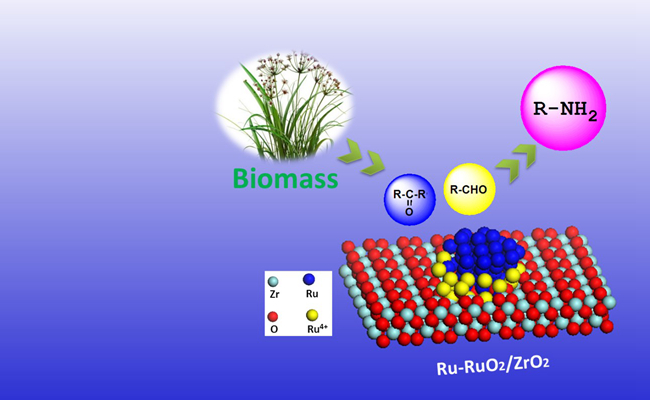Utilization of lignocellulosic biomass for production of liquid fuels and chemicals is being considered as one of the promising strategies to reduce CO2 emissions. As lignocellulose is composed of C, H and O, most of the products resulting from lignocellulose are oxygenates or hydrocarbons. In comparison, transforming lignocellulose into more valuable N-containing compounds has rarely been achieved owing to the lack of efficient amination methods for biomass-derived molecules.
A team led by prof. ZHANG Tao and WANG Aiqin, Dalian Institute of Chemical Physics, has developed an efficient approach to produce primary amines in good to excellent yields from biomass-derived aldehydes and ketones, by using a bi-functional and robust Ru/ZrO2 catalyst in aqueous ammonia under quite mild conditions. More interesting, they also demonstrated the feasibility of producing ethanolamine directly from lignocellulose, with an overall yield of 10%.

Production of primary amines from biomass-derived aldehydes and ketones (Image by LIANG Guanfeng and WANG Aiqin)
Primary amines are value-added intermediates in fine chemical industry. In particular, ethanolamine has a large market of approximately 2 MT/a as a widely used absorbent for CO2 sequestration in power plants. This work can thus provide a sustainable avenue to primary amines from renewable biomass.
This work was published on Angew. Chem. Int. Ed..The research work was financially supported by the National Natural Science Foundation of China, the National Key Projects for Fundamental Research and Development of China, and the Strategic Priority Research Program of the Chinese Academy of Sciences. (Text and Image by LIANG Guanfeng and WANG Aiqin)
Dr. LU Xinyi
Dalian Institute of Chemical Physics, Chinese Academy of Sciences,
457 Zhongshan Road, Dalian, 116023, China,
Tel: 86-411-84379201
E-mail: luxinyi@dicp.ac.cn